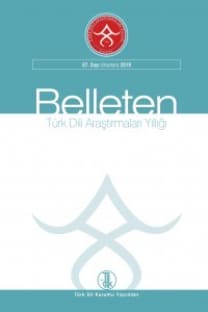Eski Uygurca Buddhāvataṁsaka-sūtra tefsirine ilişkin fragmanlar (13, 14 ve 19. Yapraklar)
Bu çalışmanın konusunu oluşturan Sanskritçe Buddhāvataṁsaka- sūtra “çiçek bezeme sūtrası” Çinceye Huayan jing adıyla tercüme edilen Budist bir eserdir. Bu eser temelinde Çin’de Budizm’in Huayan ekolü ortaya çıkmıştır. Bu ekol Çin’de gelişen on üç Budist ekolden biri olup Korecede Hwaŏm ve Japoncada Kegon adıyla bilinir. Bu yazı daha önce neşri gerçekleştirilmemiş Eski Uygurca Buddhāvataṁsaka-sūtra tefsirine ilişkin fragmanlar hakkındadır. Bugün bu fragmanlar Berlin Brandenburg Bilimler Akademisi Turfan Koleksiyonu’nda sırasıyla U 1323 (T I D), U 1326 (T I 2) ve U 1329 (T I L 4) arşiv numaralarıyla korunmaktadır. Bunlar Doğu Asya Budizmi olarak da bilinen Budizm’in Yogācāra kolundan gelişen Faxiang ekolüne ait metin parçalarının bulunduğu en az otuz bölümden oluşan bir derleme eser niteliğinde Eski Uygurca bir yazma eserin 20. bölümün 13, 14 ve 19. yapraklarını oluşturmaktadır. Bu çalışma mevzubahis yaprakların yazı çevirimini, harf çevirisini, Türkiye Türkçesine aktarmasını, metne ilişkin notlarını ve dizin-sözlüğünü içermektedir.
Anahtar Kelimeler:
Budizm, Huayan ekolü, Buddhāvataṁsaka-sūtra, metin neşri
The fragments of old Uyghur Buddhāvataṁsaka-sūtra (13th, 14th and 19th leaves)
Sanskrit Buddhāvataṁsaka-sūtra “flower ornament scripture”, which forms the subject of the paper, is a Buddhist scripture translated into Chinese with the name of Huayan jing. On the basis of this scripture, the Huayan school of Buddhism emerged in China. This school is one of the thirteen Buddhist schools that emerged in China and is known as “Hwaŏm” in Korean and “Kegon” in Japanese. These fragments are today preserved at the Turfan Collection in Berlin Brandenburg Sciences and Humanities, registered under the archive numbers U 1323 (T I D), U 1326 (T I 2) and U 1329 (T I L 4) respectively. These fragments comprise the 13th, 14th, and 19th leaves of an Old Uyghur manuscript, consisting of at least thirty chapters of the text of the Faxiang school, which developed from the Yogācāra school of Buddhism, also known as East Asian Buddhism. This paper contains the transcription and transliteration of aforementioned Old Uyghur fragment, translations into Turkish, notes and glossary with an analytical index.
Keywords:
Buddhism, Huayan school, Buddhāvataṁsaka-sūtra, text edition,
___
- Adams, D. Q. (2013). A dictionary of Tocharian B: Revised and greatly enlarged vol. 1-2. Amsterdam & New York: Rodopi.
- Aramaki, N. (2007). The Huayan tradition in its earliest period. Reflecting mirrors perspectives on Huayan Buddhism. Wiesbaden: Harrassowitz Verlag, 169-187.
- Arat, R. R. (1940-42). Uygurlarda ıstılahlara dair. Türkiyat Mecmuası, 7-8, 56-81.
- Chiu, K. P. (2016). Thomé H. Fang, Tang Junyi and Huayan thought: A Confucian appropriation of Buddhist ideas in response to scientism in twentieth-century China. Leiden & Boston: Brill.
- Clauson, S. G. (1972). An etymological dictionary of pre-thirteenth-century Turkish. Oxford: Oxford at the Clarendon Press.
- Cook, F. H. (1977). Hua-yen Buddhism: The jewel net of Indra. London: The Pennsylvania State University Press.
- Copp, P. (2012). Chinese religion in the Sui and Tang dynasties. The Wiley-Blackwell companion to Chinese Religions. New Jersey: Blackwell Publishing, 75-98.
- Çetin, E. (2012). Uygurca kiçig erŋek, Karahanlı Türkçesi çıçalak ve Türkiye Türkçesi serçe parmak sözleri üzerine. Turkish Studies – International Periodical for the Languages, Literature and History of Turkish or Turkic, 7/4, 1217-1227.
- Edgerton, F. (1953). Buddhist hybrid Sanskrit grammar and dictionary. New Haven: Yale University Press.
- Erdal, M. (1991). Old Turkic word formation: A functional approach to the lexicon vol. I-II. Wiesbaden: Harrassowitz Verlag.
- Gharib, B. (1995). Sogdian dictionary: Sogdian-Persian-English. Tehran: Farhangan. Hamar, I. (2014). Huayan explorations of the realm of reality. The Wiley-Blackwell companion to East and Inner Asian Buddhism. New Jersey: Blackwell Publishing, 145-165.
- Hirakawa, A. (1997). A Buddhist Chinese-Sanskrit dictionary. Tōkyō: Reiyukai. Monier-Williams, M. (1899). A Sanskrit-English dictionary. Oxford: Oxford University Press.
- Nadalyayev, V. M., Nasilov, D. M., Tenişev, E. R. ve Şçerbak, A. M. (1969). Drevnetyurkskiy slovar’. Leningrad: Izdat. Nauka, Leningradskoe Otd.
- Ölmez, M. (2017). Eski Uygurca ikilemeler üzerine. Türk Dili Araştırmaları Yıllığı - Belleten, 65/2, 243-311.
- Özertural, Z. (2012). Alttürkische Handschriften Teil 16: Mahāyāna-sūtras und Kommentartexte. Stuttgart: Franz Steiner.
- Poceski, M. (2004). Huayan school. Encyclopedia of Buddhism, volume I. New York: Thomson Gale, 341-347.
- Poucha, P. (1955). Institutiones linguae Tocharicae. Pars I: Thesaurus linguae Tocharicae dialecti A. Praha: Statni Pedagogicke Nakladatelstvi.
- Rhys Davids, T. W. ve Stede, W. (1921-1925). The Pali text society’s Pali-English dictionary. London: The Pali Text Society.
- Röhrborn, K. (1977-1998). Uigurisches Wörterbuch. Sprachmaterial der vorislamischen türkischen Texte aus Zentralasien, 1-6. Wiesbaden: Steiner.
- Röhrborn, K. (2010). Uigurisches Wörterbuch. Sprachmaterial der vorislamischen türkischen Texte aus Zentralasien, Neubearbeitung. I. Verben. Band. 1: ab- - äzüglä-. Stuttgart: Steiner.
- Tezcan, S. (1974). Das uigurische Insadi-Sūtra. Berlin: Akademie-Verlag. Tokyürek, H. (2019). Eski Uygur Türkçesinde Budizm ve Manihaizm terimleri. Ankara: Türk Dil Kurumu Yayınları.
- Toparlı, R., Vural, H. ve Karaatlı, R. (20072). Kıpçak Türkçesi sözlüğü. Ankara: Türk Dil Kurumu Yayınları.
- Wei, D. (2007). A fundamental feature of the Huayan philosophy. Reflecting mirrors perspectives on Huayan Buddhism. Wiesbaden: Harrassowitz Verlag, 189-194.
- Wilkens, J. (2007). Das Buch von der Sündentilgung. Edition des alttürkisch-buddhistischen Kšanti Kılguluk Nom Bitig. Turnhout: Brepols.
- ISSN: 0564-5050
- Başlangıç: 1953
- Yayıncı: Türk Dil Kurumu
Sayıdaki Diğer Makaleler
Burdur ili ağızlarının ortak karakteristik ses bilgisi özellikleri
Klasik Türk edebiyatının söz algısının gösterge bilimi açısından değerlendirilmesi
Türkçe bilgisayarlı dil bilimi çalışmalarında his analizi
Ebru AKÇAPINAR SEZER, Alaettin UÇAN
Yesevi şairi Şems-i Asi’nin Yetimnamesi
Ebu’n-nasr Sâmânî ve 19. yüzyılda yazılmış bir Uveysi tezkiresi üzerine
Eski Uygurca Buddhāvataṁsaka-sūtra tefsirine ilişkin fragmanlar (13, 14 ve 19. Yapraklar)
